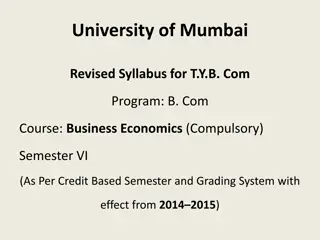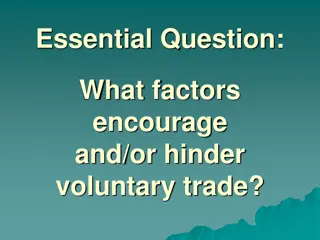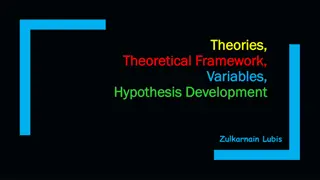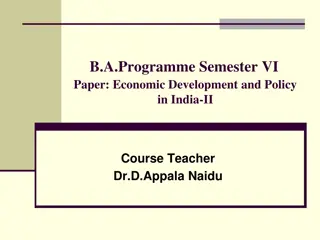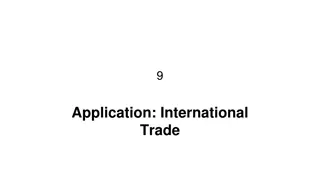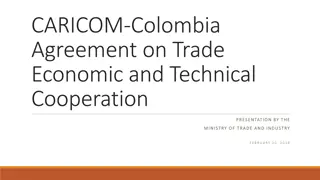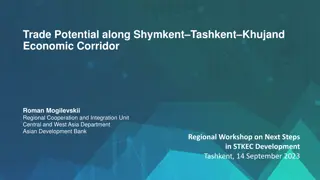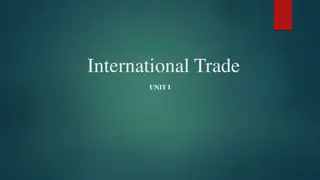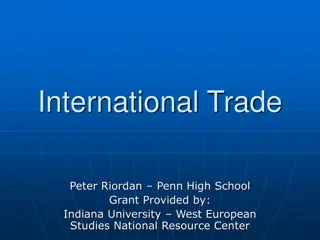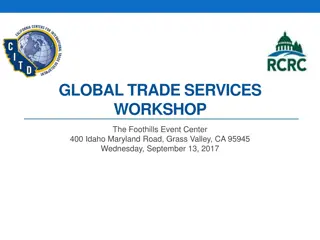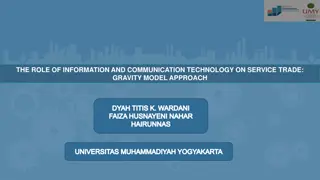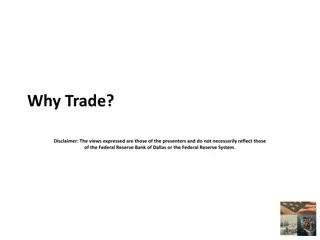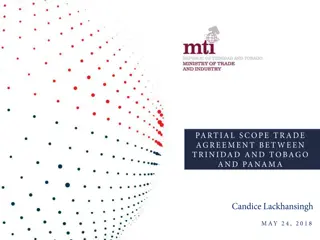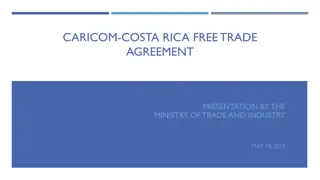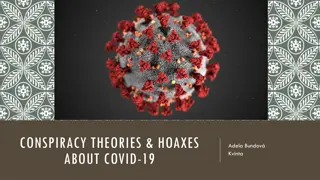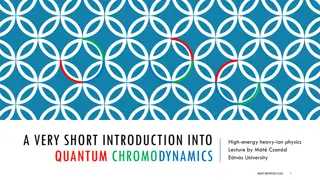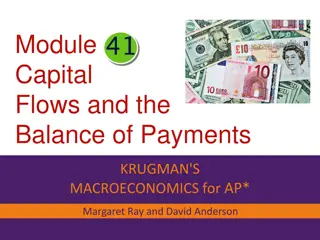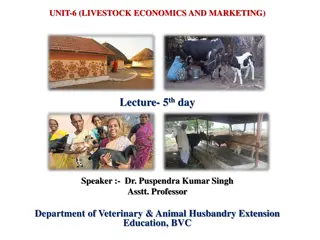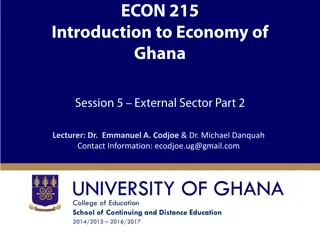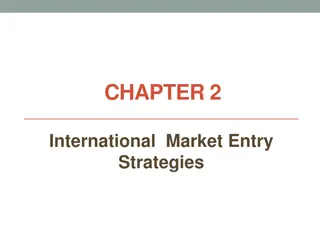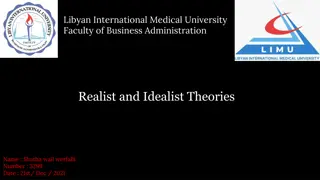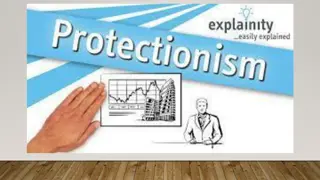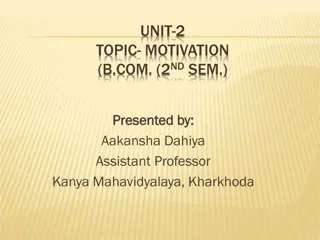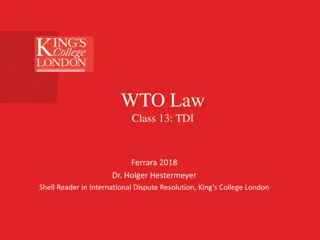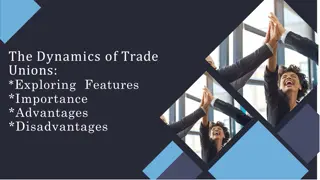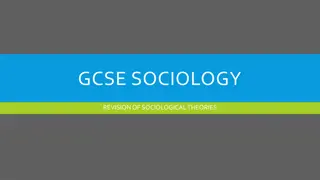Understanding International Trade: Concepts and Theories
International trade involves the exchange of goods and services between countries, driven by unequal distribution of resources. The concept of trade, types of trade, and key theories are explored in this informative content spanning from historical country-based theories to modern firm-based perspectives.
Download Presentation

Please find below an Image/Link to download the presentation.
The content on the website is provided AS IS for your information and personal use only. It may not be sold, licensed, or shared on other websites without obtaining consent from the author. Download presentation by click this link. If you encounter any issues during the download, it is possible that the publisher has removed the file from their server.
E N D
Presentation Transcript
Creative Commons License ECO 303 International Economics by Ologundudu, M.M. is licensed under a Creative Commons Attribution-NonCommercial 4.0 International License.
1.0 INTERNATIONAL TRADE GENERAL REVIEW WHAT IS INTERNATIONAL TRADE? Trade is the concept of exchanging goods and services between two people or entities. Original form of trade was barter Bilateral trade: when two people or countries are involved. Multilateral trade: if more than two people or two countries are involved.
International trade is a concept of exchange between people or entities in two different countries. The fundamental of trade is to explain why two people or two nations trade with each other respectively. The answer is simply that Nature is not evenly distributed on the surface of earth.
Trade Home Trade Foreign Trade Wholesale Trade Retail Trade Import Trade Export Trade Intra-port Trade
INTERNAL political and geographical boundaries of a country. (Wholesale or Retail). TRADE: Trade within the Wholesale bought manufacturer and then sold to the retailers for resale to consumers. Trade: large Commodities quantities are the in from Retail Trade: Commodities are bought in small quantities from the wholesalers for resale to the final consumers.
EXTERNAL TRADE: Trade across the political and geographical boundaries of a country (import, Export and intraport). Import Trade: When commodities are sold to home country from another or foreign country i.e. USA goods to Nigeria resident. Export Trade: When commodities are sold from home country to another or foreign country i.e. Nigeria good to U.S.A resident. IntraPort Trade: It occur when imported goods are re-exported back to the source country after modifying the goods to another form.
2.0 INTERNATIONAL TRADE THEORIES It is important to understand how countries trade with one another historically. The main historical theories are called classical which are country based. By mid 20 s, the theories began to shift to explain trade from firm perspective and are called company based.
Tabular presentation of both Classical and Modern based theories are depicted below: Classical Country-Based Theories Modern Firm-Based Theories Mercatilism Country Similarity Absolute Advantage Vernon s Product cycle Theory Comparative Advantage Global Strategic Rivalry Heckscher-Ohlin Porter s National Competitive Advantage Leontief Paradox Kravis Theory of Availability Linder s Theory of the Volume of Trade Kanen s Theory of Human Capital Gravity Model Posher s Technological Gap Theory
BASIS for International Trade among countries Why do nation trade? Is International trade beneficial to all? International trade theories are simply different theories that explain reason (s) for international trade among the countries in the world.
Mercantalism was one of the earliest efforts to develop an economic theory dated back as to sixteen century. This theory stated that a country s wealth was determined by the amount of gold and silver holding. Mercantalist believed that a country should increase its holdings of gold and silver by promoting exports and discouraging imports. World History from the 1500s to late 1800s revealed that mercantalism systems of trade flourished.
Within these period, there was a sudden rise of new nation. States whose rulers wanted to strengthen their nations by building larger armies and national institutions. Export trade were increased and more gold and silver were amassed. This was achieved through export promotion strategy. Later, modern thinkers such as Japan, China, Singapore, Taiwa and even Germany embraced the concept of mercantilism in what is called Neo-mercantilism. This was done by adding other features of trade protection and combining (i) Protectionist policies (ii) Trade restriction policies (iii) Domestic industry subsidies
Nearly every country has implemented some form of protectionist policy to guide key industries in its economy at one point or the other. The drawback of this system of trade are many: (i) Only export-oriented companies are direct beneficiaries of protectionist policies. (ii) Consumers are hurt by protectionist They pay higher taxes (Govt. Subsides) It trigger higher prices for consumer (Import restriction)
In the middle of 18th Century, a new system of economic thought developed in France by the name of physiocrates. This system is known as physiocracy The physiocrates argued that mercantalist blindly supported foreign trade without understanding the real or natural order. The physiocrates did not under played the importance of international trade or trade generally for the betterment of society but laid more emphasize on the importance of agriculture. According to this school of thought trade remains and will always remain relevant due to the importance attached to natural order and endowment from country to country.
In 1776, Adam Smith questioned the leading mercantiles and physiocrates philosophies of trade in his book Wealth of Nations; and Inquiry into the nature of causes of wealth of nations. He propounded a new trade theory called absolute advantage which focused on the ability of a country to produce a good more efficiently than another nation. According to the theory, trade between two countries should not be regulated or restricted by government policy or intervention. Trade should flow naturally according to the market forces.
In a hypothetical two country world, if A could produce a good cheaper or faster or both than country B, then country A had a greater advantage and could then focus on specializing in producing that goods. Similarly, if country B was better at producing another good, it could focus on specializing on producing that goods. By specialization, countries would generate efficiencies because their labour force would be more skilled by doing the same task. Production would also become more efficient. The theory conclude that with increased efficiencies, people in both countries would benefit and the world output will increase, hence trade should be encouraged. In conclusion, Adam Smith theory of absolute advantage states that a nation s wealth should not be judged by how much gold and silver it had but rather by the living standard of its people.
The challenge to the absolute advantage theory was that some countries may be better at producing both goods and therefore, have absolute advantage in many areas. In contrast, another country may not have any useful absolute advantages at all. In this situation, should trade not take place at all? David Richardo, an English Economist, answer this question by introduced the theory of comparative advantage in 1817.
Ricardo opined that even if country A had the absolute advantage in the production of both products, specialization and trade could still occur between the two countries. Comparative advantage occur when a country can not produce a product more efficiently than the other country. But she can produce the other product better and more efficiently than the other product. While comparative advantage focuses on the relative prices or productivity differences, absolute advantage focus on the absolute price or productivity.
Therefore, a country will specialize in doing what they do relatively faster and better and the overall productivity of the countries involved in the trade would be greatly enhanced. Trade can benefit both countries on the basis of cost of production which is not described in the absolute advantage model
3.0 NEO-CLASSICAL TRADE THEORIES The classical trade theories was castigated on he basis of some of its restrictive and unrealistic assumptions. The Neo Classical model of trade advocated for theory which can be extended up longer and whose concept can be easily understood by all. They therefore started their theory with the basic concepts like opportunity cost and productivity possibility frontier. The neo classical economist such as Haberler, Leontiet, lerner Marshall, Edgeworth, and meade had contributed substancially to the growth of this school of thought
1. THE OPPORTUNITY COST APPROACH. (HEBELLERS THEORY) This study of opportunity cost was to reformulate the theory of comparative cost advantage propounded by David Ricardo According to this theory, if country can produce either of commodity x or y, the opportunitycost of the commodity x is the amount of other commodity y that must be given up in order to get one additional unit of commodity x The exchange ratio between the two commodities is expressed in terms of opportunity costs. The theory of comparative cost was based on labour theory of value (LTV) LTV states that the value of commodity is equal to the amount of labour time involve in the production of that commodity.
LTV according to Ricardo assumes that labour is the only factor of production of the commodity and that it is homogeneous and fixed in the same proportion in the production of all commodities. The inherent shortcoming in this theory was resolved by the opportunity cost theory which explain the doctrine of comparative cost in terms of what Samnelson called production possibility curve. The theory of opportunity cost was based on the following assumptions: (i) Only two countries A and B can participate ion trade. (ii) Two commodities and two factors of production (Labour and Capital) (iii) The supply of factors is fixed (iv) There is full employment (v) Free trade exists between the two countries (vi) The price of each factor equals its marginal value production in each employment.
Under these theory, heavy gain from trade can be determined by different cost conditions. i.e. constant, increasing and decreasing opportunity cost. 2. MILLS THEORY OF RECIPROCAL DEMAND J.S Mill postulated the theory of reciprocal demand The term reciprocal demand was introduced by MILL to explain the determination of the equilibrium terms of trade. It is used to indicate a country s demands for one commodity in terms of quantities of other commodities it is prepared to give up in exchange. After restating the Ricardian theory of comparative cost, Mill allocated a given amount of labour to each country but different outfit. This is called Comparative effectiveness of labour as contrasted with Ricardo s comparative labour cost.
These theory of Reciprocal Demand was based on the following assumptions: Two countries, two commodities and only one factor of production (2x2x1 model) There are constant return to scale Transportations costs are totally absent There is perfect competition Full employment exists in both the country Absence of trade restriction.
4.0 INTRODUCTION The theories of Smith and Ricardo did not help countries determine which products would give a country an advantage Both theories assumed that free and open markets producers to determine which goods they could produce more efficiently According to the two swedish economists, ELI Hecksher and berlin Ohlin, they asserted that the relative availability of factor supplies mainly determine pattern of production, specification and trade among the regions.
Some countries have abundant in capital and some have much abundance in labour. They determined that the cost of any factor or resource is a function of supply and demand. The theory says that the countries that are rich in capital endowment will export capital intensive goods and the countries which that are rich will export labour intensive goods.
4.1 ASSUMPTIONS The following assumptions have been made in order to simply H-O theorem. (i) The model is based on 2 countries, 2 commodities and 2 factors of production. (ii) The existing factors and commodity market is perfect competition. (iii) Production functions are different for different commodities. (iv) Each commodity is produced by constant return to scale. (v) Transportation and insurance costs are free.
(vi) Factor of production between the countries are immobile but freely mobile within countries. (vii) There is full employment of both the factors of production in each countries. (viii) The technological knowledge remain unchanged (ix) Identical demand patterns and preferences of consumers in both the countries. The H-O theorem as discussed above were: (i) Factor abundance (or scarcity) in terms of the price criterion; and (ii) Factor abundance (or scarcity) in terms of physical criterion.
However, the classical and modern theories of international provided meaningful international trade but both the classical and modern concepts of trade are diagnosed by several limitations. The theorem thus is quite limited in its applications because of several unrealistic assumptions. 4.2 leontiff paradox In the early 1950s, a economist wassily W. economy closely and noted that the united states was abundant in capital. trade concept had of
By implication such country should produced and export capital intensive goods. His research using actual data showed the opposite: the united states was importing more capital intensive goods According to H-O theorem, the united states should have been importing labour intensive goods but rather it was actually exporting them. This contribution became known as the leontiet paradox because it was the reverse of what was expected by the H-O theory.
The question is: Does the H-O theory still have any relevance in international trade? Over the decades many economists have used different theories and data to explain and minimize the impact of the paradox in international transaction. (i) Criticism of the data and methodology used in the input-output test. (ii) The unbalanced trade problem (iii)Human capital explanation (iv)Natural resources explanation (v) Demand reversals (vi)Factor intensity reversals
5.0 INTRODUCTION The classical theory of international trade bitterly criticized by Bertel Ohlin in his famour book Interregional and international trade (1933) and then formulated the General equilibrium or factor Endowment theory of international trade. Ohlin and his teach Hecksher (known as H- O) carried the theory forward to build the theory of modern international trade.
5.1 THE KRAVIS THEORY OF AVAILABILITY In 1956, I.B Kravis, an Amrerican Economist questioned the assumptions of the classical theory that technology was the same in all trading countries. While testing the H-O theory, he wanted to find out whether labour intensive export were produced with cheap labour. He found out that in almost every country, the exporting industries pay a vert high wages to labourer.
According to him, a country produces and exports those goods which are (available) developed by its entrepreneurs. innovators and Kravis propounded the theory that the composition of community of trade is determined primarily by availablity which means an elastic supply. Trade commodities which are not available at home. only take place in those
By implications, the country will: (i) Import those goods which are not available in the country in absolute sense e.g. diamonds. (ii) Export those goods which are available more than the domestic needs. However, responsible explained by Kravis: (i) Natural Resources, Technical change, product differentiation and government policy. there for are the some availability factors as
(ii) The trade pattern of a country is determined by the availability resources. of scarce natural (iii) Availability possessed by a country labour force. of Technical knowledge (iv) Temporary monopoly of production by the product differentiation producing countries commodities. by can which export the its The government policies has proved to an obstruction which leads the trade o a negative path.
5.2 LINDER S THEORY OF THE VOLUME OF TRADE The swedish propounded a theory that explains the volume of trade in manufactures as proportion of nation income between different pairs of trading countries. economist, S.B Linder According to Linder, trade experts could be explained in terms of relative natural endowment whereas manufactures explained like that. exports cannot be For manufactures experts, there are many complex factors such as technology superiority, managerial skills and economics of scale which are considered to unpredictable. be imprecise and
In his theory, Linder asserted that the pre- condition for trade in manufacture export is a function of home demand. The following reasons was given for his assertion: (i) Foreign trade is only the extension of domestic trade. (ii) Existing industries are fully equipped with innovating centres. (iii)Foreign market is risky and the domestic market is safe. The country will only export those commodities for which the domestic markets has the highest demand.
According to Linder, the country will preferably export to those countries whose income levels and demand patterns are similar to the exporting country (Preference similarity) Preference similarity occurs in different countries and the different countries overlap. Therefore, trade relations among the countries took place and a variety of manufactured goods are produced after meeting its domestic demand.
5.3 POSNER S TECHNOLOGICAL GAP THEORY Unlike other international trade theorists like Ricardo, and Heckscher-Ohlin, who failed to analyze the effort of technological change on trade, but Kravis comprehensively pointed out the effect of technological change on available exports. M.V posner reformulated the theory of Kravis and analyzed the effect of technology on trade. According to him, the process of technological change leads to the imitation gap which influence the patterns of international trade.
Posners theory was based on the following assumptions: (i) There are two countries (ii) The factors endowments are similar in both countries. (iii)Condition of demand is similar in both countries. (iv)Both countries have different technologies. The technological gap theory explain the sequence of innovation and imitation as it affect the pattern of trade.
Innovation of new product that is profitable in the domestic market leads to temporary monopoly. If extended to importing countries (foreign market) imitation is inevitable. But the exporting countries will still have comparative advantage in its production even during and after the imitation gap. In spite of the above analysis, Posner proposed that the technological gap theory has three basic components:
(i) Foreign reaction lag: It is the time taken by the innovating firm to start the production of new product. (ii) Domestic reaction lag: learning period which is the time taken by the domestic producers to learn about the techniques of producing the new products and then selling it into the domestic market. (iii) Demand Lag: it is the time taken by the consumers to acquire the taste of the new products.
Technological gap theory is more realistic than the traditional theories because it analysed the effect of technology on the trade pattern. 5.4 VERNON S PRODUCT CYCLE THEORY Raymond Vernon, a Harvard Business School Professor developed the product life cycle in the 1960s. The Theory stated that a product life cycle has three distinct stages: (i) New product (ii) Maturing product (iii) Standardized product
This theory was based on the experience of U.S Economy and it was based o the following assumptions: (i) The development of new products by the firms made on the basis of real or imagined conferred a monopolistic advantages. (ii) The innovators are provided by the stimulus to innovate new product by the need and opportunities of the domestic market. (iii)The innovators are unaware about the conditions and situations in the foreign markets. (iv)The new products are firstly produced in the capital rich countries.
This model comprehensively demonstrates the dynamic comparative advantage. The country have comparative advantage in the production of the new product changes from innovating country to the developing countries. However, the model is usually applied to the labour saving and capital using products developed in the high income groups. The product life cycle is further elaborated with the aid of five stages: (i) Introduction (ii) Growth (iii) Maturity (iv) Saturation (v) Decline







